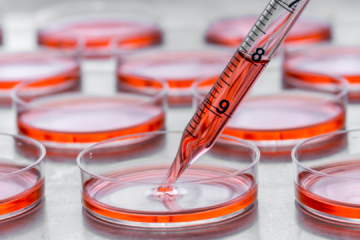Lipogenesis and adipogenesis are metabolic processes associated with the storage of fat in the body. While closely interconnected, they represent distinct stages in the process of fat accumulation.
This article will examine the primary physiological mechanisms implicated in lipogenesis and adipogenesis processes. Additionally, it will explore the mechanisms of action and validation methodologies for cosmetic ingredients that effectively inhibit both processes, thereby facilitating the reduction of localized fat.
Physiological Mechanisms of Lipogenesis
Lipogenesis is the process by which fatty acids and triglycerides, which are fat molecules, are synthesized from excess energy sources like carbohydrates and proteins. It primarily occurs in the liver but also takes place in other tissues such as adipose tissue, muscles, and mammary glands. Lipogenesis is regulated by a variety of enzymes and transcription factors that govern gene expression and metabolic pathways involved in fat synthesis.
The principal mechanisms of action underlying lipogenesis encompass:
Glucose Uptake
Glucose is transported into cells through glucose transporters (GLUTs) and undergoes conversion to glyceraldehyde-3-phosphate, a critical intermediate in the process of fatty acid synthesis.
Glycolysis
Glucose undergoes glycolysis, a metabolic pathway occurring in the cytoplasm of the cell, resulting in the conversion of glucose to pyruvate. Subsequently, pyruvate is further transformed into acetyl-CoA, which is transported into the mitochondria.
Conversion of acetyl-CoA to citrate
Inside the mitochondria, the acetyl-CoA derived from glycolysis undergoes conversion to citrate catalyzed by the enzyme citrate synthase.
Transport of citrate to the cytosol
The citrate formed in the mitochondria is transported to the cytosol by means of a specific transporter.
Fatty acid synthesis
In the cytosol, citrate is converted back into acetyl-CoA and malonyl-CoA, which are the building blocks for fatty acid synthesis. These fatty acids are then combined with a glycerol molecule to form triglycerides.
Physiological Mechanisms of Adipogenesis
Adipogenesis is characterized as the process of differentiation of mesenchymal stem cells into adipocytes, which are specialized cells for fat storage. Adipogenesis occurs primarily in adipose tissue, although it can also occur in other tissues to a lesser extent. It is regulated by a complex network of transcription factors and hormonal signals.
The main mechanisms of action of adipogenesis involve:
Stem cell proliferation and differentiation
Mesenchymal stem cells present in adipose tissue multiply and differentiate into immature adipocytes, known as preadipocytes.
Accumulation of fat
Preadipocytes accumulate lipids and increase their size, forming fat droplets in the cytoplasm.
Maturation of adipocytes
Pre-adipocytes undergo a maturation process, in which morphological and biochemical changes occur that lead to the formation of mature adipocytes.
Secretion of Adipokines
Mature adipocytes secrete a number of bioactive substances, known as adipokines, which play an important role in metabolic regulation, inflammation, and hormone signaling.
Both processes, lipogenesis, and adipogenesis, play essential roles in energy metabolism and fat storage in the body.
Cosmetic ingredients can act by inhibiting lipogenesis and adipogenesis, contributing to the reduction of localized fat. Next, we will present more details about their mechanisms of action and techniques for validating the efficacy of cosmetic ingredients against lipogenesis and adipogenesis, in order to promote this claim.
Mechanisms of action of cosmetic ingredients
Cosmetic ingredients effective against adipogenesis and lipogenesis can act through different mechanisms.
Here are some of the main ones:
Inhibition of Lipogenic Enzymes:
Some ingredients may inhibit enzymes involved in the synthesis of fatty acids and triglycerides, thereby reducing lipogenesis. These enzymes include acetyl-CoA carboxylase and the enzyme glycerol-3-phosphate dehydrogenase. By inhibiting these enzymes, the ingredients can help reduce fat production and storage. Examples of ingredients with this property include plant extracts such as green tea, kelp, and green coffee.
Stimulation of Lipolysis:
Lipolysis is the process of breaking down triglycerides into free fatty acids and glycerol. Cosmetic ingredients can stimulate lipolysis, thereby promoting the release of fat stored in fat cells. This can be achieved through the activation of enzymes such as hormone-sensitive lipase (HSL). Caffeine is an example of an ingredient that can stimulate lipolysis.
Modulation of adipocyte differentiation:
Some ingredients may influence the differentiation of stem cells into adipocytes, thereby controlling the formation of new fat cells. This can be achieved through the regulation of transcription factors and signaling pathways involved in the adipogenesis process. Retinoic acid (vitamin A derivative) is an example of an ingredient that can modulate adipocyte differentiation.
Increased thermogenesis:
Thermogenesis is the process by which the body generates heat and burns calories. Ingredients that promote thermogenesis can increase energy expenditure and therefore help reduce body fat. Capsaicin, found in red peppers, is an example of an ingredient that can increase thermogenesis.
Efficacy validation methodologies of cosmetic ingredients
There are several methodologies and in vitro techniques used to validate the efficacy of cosmetic ingredients against adipogenesis and lipogenesis. These assays provide an accurate assessment of the ingredients’ potential to modulate these metabolic processes.
Here are some of the commonly employed techniques:
Differentiation of pre-adipocyte cells:
In this assay, pre-adipocyte cells are cultured and induced to differentiate into mature adipocytes. Cosmetic ingredients are added during the differentiation process to assess their effect on adipocyte formation. The number of formed adipocytes can be determined by different markers, such as the quantification of intracellular triglycerides.
Intracellular lipid accumulation:
In this approach, pre-adipocyte cells or already differentiated adipocytes are exposed to cosmetic ingredients, and intracellular lipid accumulation is assessed. Lipophilic dyes such as Oil Red O are often used to label and quantify lipids accumulated in adipocytes.
Lipogenic enzyme activity:
These assays measure the activity of enzymes involved in the synthesis of fatty acids and triglycerides, such as acetyl-CoA carboxylase and glycerol-3-phosphate dehydrogenase. Cosmetic ingredients are tested to see if they are able to inhibit the activity of these enzymes.
Release of fatty acids:
This test evaluates whether cosmetic ingredients stimulate lipolysis, that is, the release of fatty acids from adipocytes. Adipocytes are treated with the ingredients and the amount of fatty acids released in the culture medium is quantified using biochemical methods or specific kits.
Gene expression:
Gene expression analysis can be performed using techniques such as RT-qPCR or DNA microarrays. These assays allow evaluation of how cosmetic ingredients influence the expression of genes involved in adipogenesis and lipogenesis. The expression of the ATGL, HSL, and PRDM genes is commonly evaluated for their direct relationship to the mechanisms of lipogenesis, as outlined below:
- ATGL (Adipose Triglyceride Lipase) Genes:
The ATGL gene encodes the hormone-sensitive lipase enzyme known as ATGL. This enzyme plays a key role in breaking down triglycerides (lipolysis) stored in fat cells. The analysis of ATGL gene expression allows the evaluation of the production levels of this enzyme and its influence on lipolysis.
- HSL (Hormone-Sensitive Lipase) Genes:
The HSL gene encodes another enzyme called hormone-sensitive lipase (HSL). This enzyme is also involved in lipolysis and is responsible for degrading triglycerides into free fatty acids and glycerol. Analysis of HSL gene expression is relevant to understanding the ability of adipose cells to release fat during the lipolysis process.
- PRDM (Positive Regulatory Domain Containing) Genes:
The PRDM genes belong to a family of genes that encode transcription factors involved in the regulation of gene expression. These genes may be involved in metabolic processes, including lipogenesis (fat formation). Analysis of PRDM gene expression can provide information on lipogenesis activity in fat cells.
The RT-qPCR technique (Real-Time Polymerase Chain Reaction) is widely used to measure the relative amount of specific mRNA of these genes in a sample of cells or tissues. The technique involves the reverse conversion of mRNA to cDNA (complementary DNA) using the enzyme reverse transcriptase. Next, real-time PCR is performed to amplify and quantify the cDNA, allowing the detection of expression of the genes of interest.
When evaluating the effectiveness of a cosmetic ingredient against lipogenesis, the analysis of the expression of the ATGL, HSL, and PRDM genes by RT-qPCR allows for observing changes in the mRNA levels of these genes in response to treatment with the ingredient. If the expression of these genes is reduced, it may indicate a reduction in lipogenesis and therefore suggest that the cosmetic ingredient is effective in inhibiting this process.
The physiological mechanisms of adipogenesis and lipogenesis are robust and cosmetic ingredients can play a significant role in their inhibition and subsequent localized fat reduction. Using precise methodologies and techniques, such as those presented above, is essential to validate its effectiveness.
Crop Approach
Crop Biolabs is an integrated external R&D facility, specializing in a variety of preclinical and analytical services, external quality assessment, and phenotypic and molecular assays for cosmetic ingredients, cell-based therapeutics, pharmaceuticals, and sanitizing companies, in addition to providing claim substantiation and safety evaluations from discovery to regulation for new solutions and bespoke products.
Our mission is to collaborate with the technological maturation of products and developments in life sciences, either with a punctual service or with a complete R&D solution: from idea to impact.
Learn more about Crop Biolabs and get in touch. Let’s work together: https://cropbiolabs.com.br/
The Next-generation of Preclinical Services
Author: Carolina Barizan, Biomedical Scientist. Marketing Analyst, Crop Biolabs.




